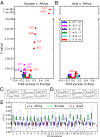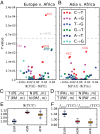Evidence for recent, population-specific evolution of the human mutation rate
- PMID: 25733855
- PMCID: PMC4371947
- DOI: 10.1073/pnas.1418652112
Evidence for recent, population-specific evolution of the human mutation rate
Abstract
As humans dispersed out of Africa they adapted to new environmental challenges, including changes in exposure to mutagenic solar radiation. Humans in temperate latitudes have acquired light skin that is relatively transparent to UV light, and some evidence suggests that their DNA damage response pathways have also experienced local adaptation. This raises the possibility that different populations have experienced different selective pressures affecting genome integrity. Here, I present evidence that the rate of a particular mutation type has recently increased in the European population, rising in frequency by 50% during the 40,000-80,000 y since Europeans began diverging from Asians. A comparison of SNPs private to Africa, Asia, and Europe in the 1000 Genomes data reveals that private European variation is enriched for the transition 5'-TCC-3' → 5'-TTC-3'. Although it is not clear whether UV played a causal role in changing the European mutational spectrum, 5'-TCC-3' → 5'-TTC-3' is known to be the most common somatic mutation present in melanoma skin cancers, as well as the mutation most frequently induced in vitro by UV. Regardless of its causality, this change indicates that DNA replication fidelity has not remained stable even since the origin of modern humans and might have changed numerous times during our recent evolutionary history.
Keywords: UV damage; genetic variation; human evolution; molecular clock; mutation rate.
Conflict of interest statement
The author declares no conflict of interest.
Figures



References
-
- Cann RL, Stoneking M, Wilson AC. Mitochondrial DNA and human evolution. Nature. 1987;325(6099):31–36. - PubMed
-
- Loomis WF. Skin-pigment regulation of vitamin-D biosynthesis in man. Science. 1967;157(3788):501–506. - PubMed
-
- Jablonski NG, Chaplin G. The evolution of human skin coloration. J Hum Evol. 2000;39(1):57–106. - PubMed
Publication types
MeSH terms
Grants and funding
LinkOut - more resources
Full Text Sources
Other Literature Sources
Research Materials

